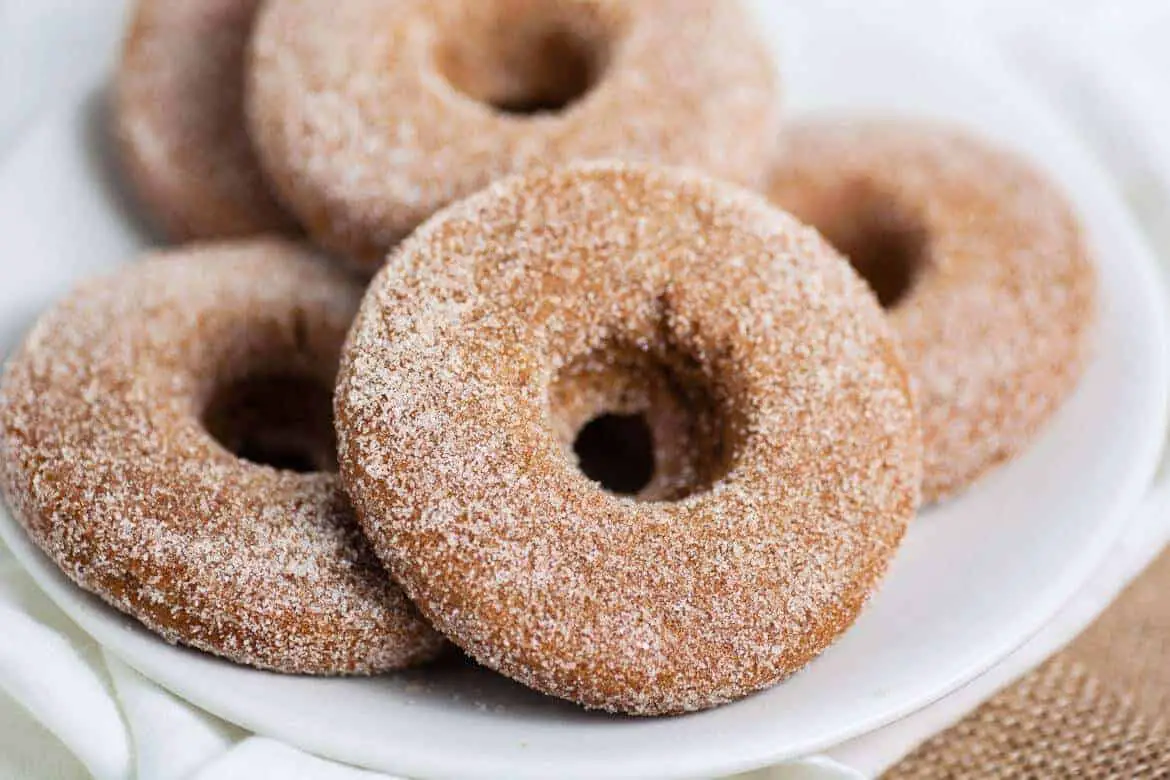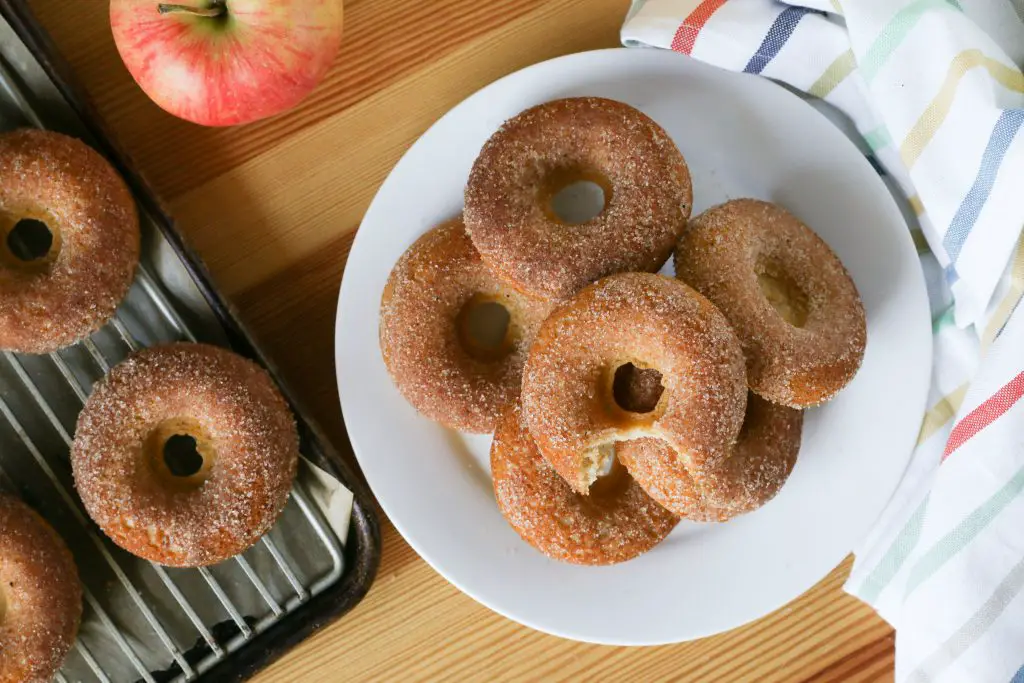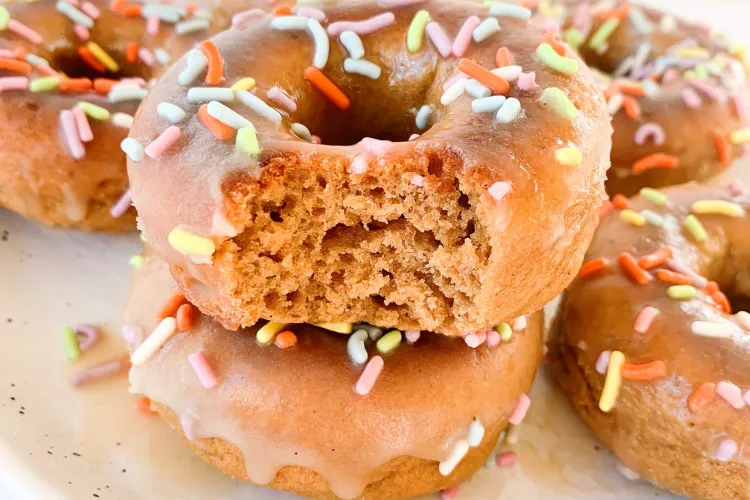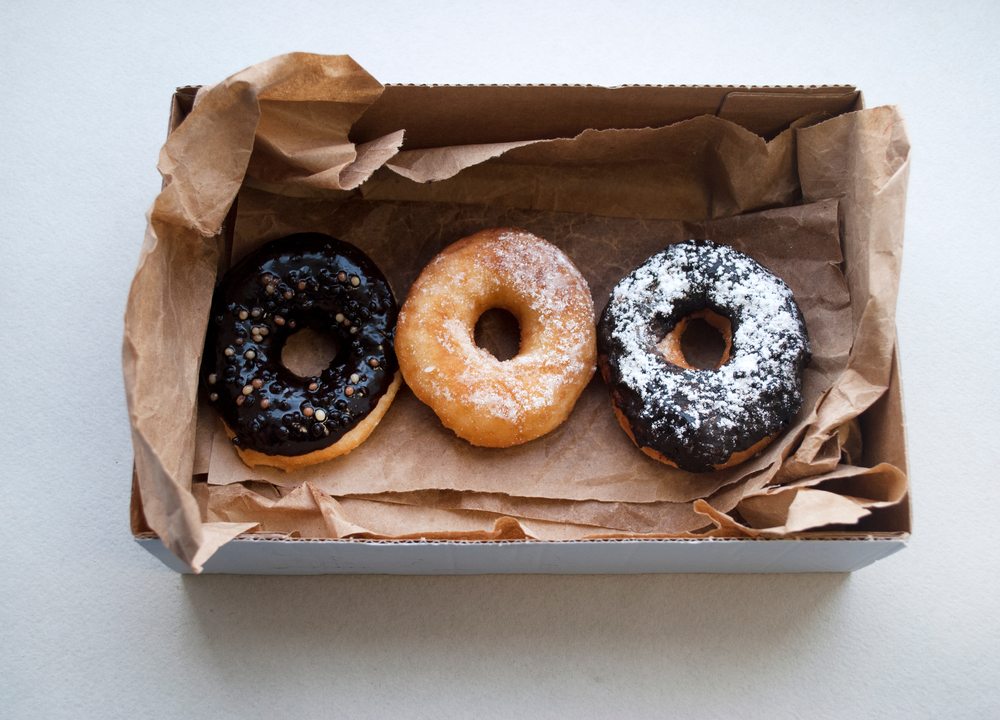You’ve almost certainly seen an advertisement or label in the supermarket that says “gluten-free.”
Many people believe it is a type of diet to lose weight because it is in a separate section in most supermarkets.
Gluten-free products are frequently paired with vegan foods such as almond milk or rice crackers, which many people buy for flour-free diets.
However, a gluten-free diet will not help you lose weight. It is a necessary diet for people who have celiac disease.
Gluten-free products are also recommended for people who are not celiac but have gluten sensitivity. This will alleviate the disease’s symptoms.
Following a gluten-free diet may appear to be a difficult task for many people, and many people associate it with eating less tasty foods, but this is a myth.
We will not only present everything you need to know about a gluten-free diet in this article, but we will also provide you with a delicious recipe for homemade gluten-free doughnuts and a list of other recipes will enjoy making.
This way, you’ll see that eating gluten-free is possible and that there are a variety of gluten-free alternatives.
We guarantee that whether or not you are celiac, you will want to try these recipes. Let’s get started!
What exactly is gluten?
Gluten is a protein complex found in all flours made from wheat, barley, or rye.
Gluten also lends an elastic texture and consistency to flour-based products such as bread, pasta, cakes, and, of course, donuts.
What is the need for a gluten-free diet?

One of the main reasons people with celiac disease should eliminate gluten is to avoid long-term damage to the small intestine.
If you are not celiac and your doctor has advised you to follow this diet, do so without hesitation. You will not only solve stomach problems in the short term, but you will also benefit your health in the long run, which is always a good reason to do it.
Regarding celiac disease
It is an autoimmune disease that is triggered by gluten-containing foods.
An autoimmune disease occurs when the immune system attacks one of the body’s organs like the intestines in this case.
When the immune system attacks the intestines, the intestinal lining is damaged. You can notice this by symptoms such as stomach pains, diarrhea, weight loss, anemia, and, in the case of a child, growth retardation.
Rashes and headaches are also common symptoms. The most important thing to remember is to go for a check-up, even if they do not have any serious reactions.
It is always preferable to consult with a specialist and follow their recommendations or prescriptions.
Following a gluten-free diet may appear difficult at first, but don’t worry because you’ll discover that there are many delicious alternatives to traditional flours.
Things to remember
Not every gluten-free diet is beneficial to your health. Fiber, calcium, and iron are nutrients and vitamins that a gluten-free diet does not provide.
That is why, if you have celiac disease or are gluten sensitive, you must consult a doctor and a specialized dietitian to develop a healthy and balanced eating plan for you.
It is also important to remember that not all gluten-free products are healthy. Many of these products are high in sugars or fats.
You can also find gluten in less obvious products such as candies, soups, stews, sauces, toothpaste, supplements, vitamins, and even lipstick.
You should also be cautious of gluten-containing products that are not intended for human consumption, such as oatmeal soaps or some lotions.
Although gluten cannot be absorbed through the skin, you must be cautious of certain customs that may cause you to consume it without realizing it.
You may be ingesting gluten unknowingly if you bite your nails, which are left with soap particles, or touch food with your hands after applying body lotion.
What foods should you avoid?
Because we are not always clear about which foods contain gluten, we leave you with a list of foods to avoid if you have gluten issues.
Any food containing wheat, rye, or barley is strictly forbidden. Other types of wheat, such as granola, durum wheat, Kamut, or semolina, should also be avoided.
Pastries, bread, beagles, cookies, cereal, tortillas, ice cream cones, pretzels, pizza, pancakes, and waffles are some of the items available.
There are also less obvious foods like dressings, meat sauces, malt, beer, malt vinegar, smoke flavoring, soy sauce, and various vegetarian products that replace beef and chicken burgers with vegetarian versions.
Remember that this is not a complete list of all foods that contain gluten. Do a thorough investigation if you suffer from celiac disease and look at the labels and their ingredients.
Gluten-free grain
- Amaranth
- brown rice flour
- buckwheat
- Arrowroot
- cassava flour
- Cob (corn) and corn flour
- Cornstarch
- Carob flour
- Flour or bean paste
- kasha
- corn dough
- Cornmeal
- Darling
- Malanga
- Kuzu root starch
- Teff or teff flour
- Pea or lentil flour
- Potato starch
- Quinoa or quinoa flakes
- rice bran
- dried fruit flour
- Rice (brown, white, or wild)
- sago flour
- sorghum flour
- Sweet potato or sweet potato flour
- Potatoes, potato flour
- Tapioca flour, tapioca starch
Gluten-Free Donuts Recipe

We arrived at the section that everyone had been looking forward to. Here is a basic recipe for gluten-free donuts, and we will later present options for varying your recipe.
Making gluten-free donuts takes some practice until they are perfect.
It can be hard to achieve the fluffiness and crispy crust of wheat flour, but if you know how to mix the right flours, it is possible. Keep in mind that practice makes perfect.
Ingredients
- 300 gr of gluten-free flour
- 100 gr of rice flour
- 1 tablespoon of vanilla essence
- 2 large eggs yolks
- 2 tablespoons fresh gluten-free yeast
- 3 tablespoons of melted butter
- 1 cup milk
- ¼ cup sugar
- Pinch of salt
Preparation
Step1 In a medium mixing bowl, combine the egg yolks, sugar, and vanilla extract and thoroughly combine them.
Step2 Combine the warm milk, yeast, and a teaspoon of sugar in a small mixing bowl. The sugar helps the yeast to activate more easily. When this mixture is foamy, add it to the previous sugar, egg, and vanilla batter and whisk well.
Step3 Combine all of the dry ingredients in a large mixing bowl and strain through a strainer to make them finer. This is done three times.
Step4 Combine the wet and dry ingredients and knead the dough for 15 minutes. Knead the dough until it is elastic and uniform. It will initially stick to your hands, but as you knead it, it will gradually come off.
Step5 Let our donut dough rest for 3 hours at room temperature, or until it has doubled in size. Traditional doughs take about an hour to double in size but keep in mind that this recipe is gluten-free, so fermentation and cooking times will vary.
Step6 Using a kitchen rolling pin, flatten the dough until it is one or two centimeters thick.
Step7 We cut the donuts with a round mold or if we don’t have molds, with the mouth of a glass. Then we make a second cut in the center to give them their traditional ring shape. To make this small circle, use glass for alcohol shots or any object with a diameter of two or two centimeters.
Step8 Place the donuts on a tray lined with parchment paper to prevent sticking and cover with a clean cloth for an hour.
Step9 Following this, we fry our gluten-free donuts in hot oil. Remember that the donuts should be floating in the oil and not touching the pot’s surface.
Step10 Fry for one minute on each side or until golden brown. Then we let them rest on a paper towel and sprinkle them with powdered sugar to give them a final touch or any kind of sprinkles.
Other Great Gluten-Free Donuts Recipes
To show you how versatile gluten-free donuts can be, we’ve compiled a list of recipes that you can make at home using various flours and methods of preparation and decoration. We hope you like them.
Glazed Gluten Free Donuts | Krispy Kreme Copycat
These donuts are meant to resemble a gluten-free version of the Krispy Kreme franchise. Not only is this a delicious recipe that you can easily make at home, but they also show you how to fry them in an air fryer to save calories. Delicious and nutritious. Can you ask for anything more?
Gluten-Free Baked Vanilla Doughnuts
These vanilla glazed donuts are a great option for those who don’t want to go through the hassle of proofing the dough and then frying it in oil and prefer a quick and easy snack. The white icing allows you to decorate it in a variety of ways with whatever toppings you can think of. Try it out!
Paleo Donuts
If you want to do something practical and quick, these donuts are ideal. Paleo donuts freeze well and keep for a long time in the fridge, so this recipe is ideal if you have a large number of children at home and want to make a quick and easy snack they can eat all week.
Donut Holes in Gluten-Free Chocolate Donuts
If you’re a fan of Dunkin’ Donuts chocolate munchkins, this recipe is for you. But we dare to say the recipe is even better because it’s gluten-free and includes instructions for coating them completely in a chocolate layer that looks like a truffle. Can you imagine the texture and flavor of a donut combined with the appearance of a chocolate truffle? It makes us salivate.
Hostess-Style Crunch Donettes
If you like donuts with different textures, these crispy donuts are the perfect recipe for your movie nights. These donuts are baked and then covered in a honey or caramel coating before being tossed in a mixture of crunchy, honey-coconut flavored crumbs.
Remember that you can get creative with the toppings and ingredients, but we strongly recommend that you stick to the original recipe. They are fluffy on the inside and crispy on the outside, making them a favorite on this list.
The Market’s Best Gluten-Free Donuts

For those who aren’t very good at baking or just don’t want to spend a lot of time in the kitchen making donuts, supermarkets offer ready-made, frozen, gluten-free donuts.
I’m sure you’re wondering if buying them frozen is a good idea. They will never be as good as homemade versions, but they can save you if you don’t have time to make them yourself.
You just have to make sure to thaw them ahead of time and read the directions carefully because they can be easily cooked in a microwave oven if you follow the directions exactly.
There are two brands that have the best gluten-free donuts out of all the options.
The first brand is Kinnikinnick, a Canadian company that allows you to buy them online and have them delivered to your home without you having to lift a finger.
Kinnikinnick offers cinnamon sugar donuts that have been dipped in chocolate and glazed in vanilla. Special mention should be made of their Maple donuts, which, as everyone knows, are a Canadian specialty.
Katz is the second brand that comes highly recommended. The texture, glaze, and consistency of the dough distinguish these donuts.
This brand offers a wide range of flavors. In addition to the classic chocolate, glazed, and powdered donuts, jelly donuts, ginger, and pumpkin-flavored donuts are available. They frequently introduce new seasonal flavors, so you’ll never be bored.
If you can’t find it in your local store, you can order it online, but keep in mind that the company is Jewish and does not work on Jewish holidays.
What Is the Difference Between Cake and Yeast Donuts?
Donuts are classified into two types: cake donuts, which are typically baked in the oven, and yeast donuts, which can be baked in the oven as well as fried.
Cake donuts are simple cake dough donuts to which you can add powdered sugar, brown sugar with cinnamon, or make a glaze of your favorite flavor.
To be honest, the cake donut dough doesn’t feel like traditional donut dough; it’s simply a cake with some decoration and a donut shape, nothing more.
It’s fine for anyone who enjoys pie crust, but those who are die-hard donut fans will miss the crispy crust and fluffy texture of a traditional donut.
Yeast donuts are lighter and have a mild yeasty flavor. They pair well with a classic galzé, such as one reminiscent of the best Krispy Kreme donuts.
Most gluten-free donut recipes are similar to cake donuts, and it is difficult to find a recipe that truly replicates the classic donuts.
The basic elements to achieve this consistency are included in the recipe, but we will also provide you with other options so that you can experiment with different types of flour to find your best option.
Oatmeal
The oatmeal variation lightens the dough slightly. When the donuts are fried, they become more spongy and airy.
Gluten-free oatmeal blends beautifully with sweet rice flour, millet flour, and tapioca flour.
If you don’t have access to a store that sells oatmeal, we recommend making your own.
Simply purchase gluten-free oatmeal and process it in a food processor or blender.
After thoroughly blending, sift it and pass it through a sieve to remove any pieces that did not grind.
All the pieces of oats that are not pulverized can be passed through the food processor or blender until you get a very fine granule.
You can also repeat the blending process about 3 times to make sure the oats are finely ground.
Almond flour
Although the almond flour provides a nice chunky texture when chewed, the donuts do not rise as tall and fluffy as other flours.
Almond flour is slightly sweet, which makes it ideal for cakes or fried donuts, as it leaves a small sweetness in the dough that reminds us of traditional gluten-free donuts.
In general, it is very good in terms of consistency and flavor, but do not wait too long for them to mature.
If you cannot tolerate walnut flour, you can always substitute oatmeal for it.
You can add a little tapioca flour to the dough to make it more spongy. This flour contributes significantly to the chewiness of the dough by making it more airy and fluffy.
We strongly advise combining the oatmeal and tapioca flour to achieve a precise balance of flavor and texture. The donuts will be very dense and heavy without the tapioca, and the flavor will be greatly diminished without the oatmeal.
Final Words
We hope you found this article to be extremely beneficial. Remember that if you experience stomach pains after consuming flour-derived products, you should consult a doctor to determine whether you are celiac or gluten-sensitive.
If you have any of these diagnoses, don’t be discouraged; it’s not a difficult disease to manage; you just need to make some dietary changes and replace gluten-containing flours with gluten-free alternatives, such as oatmeal or almonds.
It also does not imply that you will stop eating delicious foods. We hope that the list of gluten-free donut recipes has demonstrated this and encouraged you to try the recipes and share your own experiences with us.
